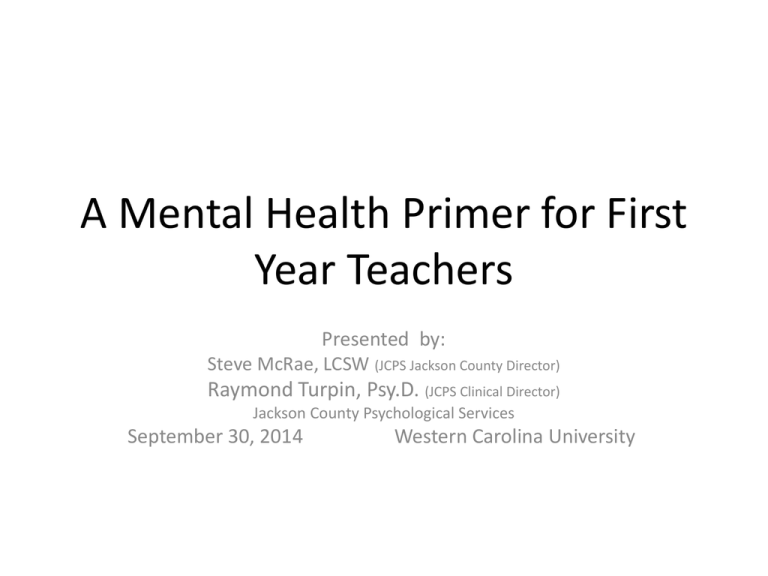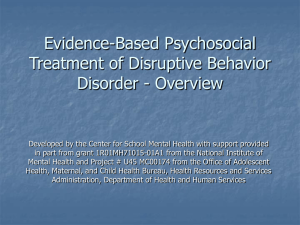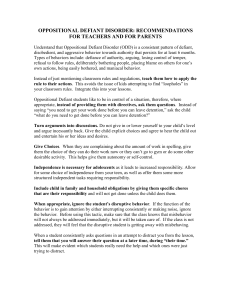School-Based Crisis Management
advertisement

A Mental Health Primer for First Year Teachers Presented by: Steve McRae, LCSW (JCPS Jackson County Director) Raymond Turpin, Psy.D. (JCPS Clinical Director) Jackson County Psychological Services September 30, 2014 Western Carolina University School-Based Behavior Management Challenging Students Externalizing Disorders: Attention-Deficit Hyperactivity Disorder (ADHD) • Symptoms of inattention or hyperactivity, impulsivity. Off-task, disorganized, walking around, noises. Oppositional Defiant Disorder (ODD) A pattern of negativistic, hostile, and defiant behavior. Disruptive. Challenges to authority, arguing, etc. Conduct Disorder Basic rights of others or major societal rules are violated Internalizing Disorders: Anxiety Disorders Uncontrollable excessive worry, restlessness, poor concentration, sleep disturbance. Avoidant, somatic complaints/bathroom issues, excessive tardiness/absences. Depression Depressed mood, decreased interest, hopelessness, fatigue. Isolating, not completing work, no motivation, disinterested in help. Trauma Distress, avoidance, intrusive thoughts related to “traumatic“ event. Shut down, reactive, irrational, inconsistent responses. Learning Disorders Difficulties learning and using academic skills. Avoidant, frustrated, acting-out better than being labeled “unintelligent”. Autism Spectrum Persistent deficits in social interaction, restrictive, repetitive patterns of behavior/interest. Poor socialization, does not respond to typical social cues, can appear as passively defiant, unresponsive to general strategies Classroom Structure • Token Economy and Contingency System (Reward/Consequence) for early grades. –Lots of initial work and adjustment required. –A moving target for some students. –Incremental periods of evaluation based on attention ability, potential for success. • Simple rules, clearly and positively stated. • Behavioral Assignment (3rd grade up)-have a simple written exercise for students to complete when they have a significant behavioral issue. It should identify what was going on before, during and after incident. It should identify what they got out of the behavior, and they should come up with better alternatives to meet that need. Should take them about 10 minutes of their free time to complete when they are calm and collected. Contract. Move on… Classroom Management- Approaches and Techniques • Personal Style-you have had all kinds of teachers, think about what worked and what didn’t for you and others. Habits… – Clear directives, positively framed as much as possible. – Firm but supportive – Consistent follow through. Give yourself some range and have the range of response aligned with seriousness of concern. • Awareness – Differences in perceptions, intentions, and interests between students and teacher, miscommunication. – Cultural differences-things that may guide interaction such as male vs female roles, eye contact, social status, etc. • Be attentive to sensory modalities – Visual, auditory, kinesthetic. • Boundaries-professional role (friend vs mentor) Ownership of classroom-students as guests. • Use reframing to diffuse or redirect uncomfortable or ignorant comments. • When dealing with attention-seeking or minor “inappropriate” comments, ignore, redirect, and distract accordingly and address directly after class. • Choose your battles at your convenience as much as possible, but do ultimately address minor issues prior to escalation. • “Schedule” interventions and be prepared ahead of time with a plan. • Don’t back a student into a corner. Give them a way to save face. • Use “apparent options”!!! • Avoid lecturing on behavior-serves your need not theirs • Avoid multiple, simultaneous directives/questions • Use “I” and “We” instead of “You” to problem solve • Prompt prior to expectation (“In 5 minutes we will…”) • Teens and confrontation. Teens can operate on emotions and try to make it personal. Stick with facts and de-escalate emotionally. Don’t take it personally. Avoid the power strugglechange timing and process of confrontation to your advantage. • Social media impacts classrooms. Be aware. (Perceived connectedness, interaction, relationships, but also bullying, threats, alienating) • Engage in time with students outside of classroom when possible and appropriate-RELATIONSHIP! • How do you know these things work? • The Big Guns-Runaway, Mattress, Mom Family EngagementThe Missing Ingredient Parent behaviors often give rise to, reinforce and perpetuate the child’s behavior. Qualities of a dysfunctional family system may include: • Absence of rules • Little monitoring of children • Lack of contingencies • Limited problem solving abilities-”Jess” • Lack of positive attention for appropriate behavior • Unknowing reinforcement of negative behaviors-”I want…” • It is hard to make things work for many of these families! • There are often reasons these students are not making it to school, not completing work. Major Factors Impacting Families • Substance Abuse (disorganization, chaos, survival mode) Everything else takes a back seat. • Domestic Violence (aggression, fighting at school, trauma, poor concentration) “That boy needs someone to whip his tail” • Poverty (increased stress at home, self-esteem) Meeting Basic needs comes first Engaging Families You MUST work to get parents of challenging students involved. • Communication-Email, text, phone, morning drop off, etc. Relationship again. • Transportation-school social workers, home visits. Early Intervention Program • Positive and supportive approach vs. more problems Helping Families with Structure Goal is to create a parallel system at home that mirrors, to some extent, what is in place in the school setting. • Team approach-Seek help from Guidance Counselors and School Social Workers. • Communication drives the system and must be ongoing, especially early on. • Positive focus with worthwhile incentives. Know Your Resources • Guidance counselor-depressed, isolated, aggressive students, peer relations, clinical needs. • Social Worker-suspected or reported abuse, neglect, basic needs, parent custody questions, DJJ needs. • Resource Officer-illegal acts, fighting, truancy. Administration-learn your school’s process. • Systems in place such as PBIS, STEPS. • Locate written protocols for reporting behavioral issues. • DPI modules on “Understanding Student Behavior” • Document events (or it never happened). • Referrals to Alternative School, speech, learning needs, psychological testing, physician, counseling, other. Contact Information Steve McRae, LCSW Jackson County Director Jackson County Psychological Services smcrae@jcpsmail.org (828)506-2858










